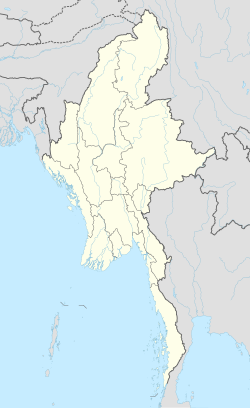Mong Ko
Mong Ko
မုန်းကိုးမြို့ 勐古 Monekoe, Man Guo, Man Kan | |
|---|---|
Town | |
 | |
| Coordinates: 24°6′1″N 98°18′50″E / 24.10028°N 98.31389°E | |
| Country | |
| State | |
| District | Mu Se District |
| Township | Mu Se Township |
| Elevation | 1,480 ft (450 m) |
| Population | |
| • Town | 24,565 |
| • Urban | 8,847 |
| • Rural | 15,718 |
| Time zone | UTC+6:30 (MMT) |
Mong Ko (Burmese: မုန်းကိုးမြို့; Chinese: 勐古; pinyin: Měng gǔ), sometimes spelled Mongko or Monekoe and also known as Man Kan, Man Guo[3] and Panglong,[4] is a town in Mu Se Township, Mu Se District, northern Shan State.
Like many towns in the region, Mong Ko is known to be a hotspot for drug production and trade.[5]
Geography[]
Mong Ko lies by the China–Myanmar border, 25 km east of Pang Hseng (Kyu Koke).[6] There is a border checkpoint in the town.[7] The town on the Chinese part of the border is Manghai in Mangshi county-level city, Yunnan Province.
History[]
The Communist Party of Burma (CPB) entered Shan State on New Year Day 1968, captured Mong Ko, and established the first war zone ‘303’ of the CPB North-East Command (NEC). This was quickly followed by ‘404’ in Kokang substate winning over the local warlord Pheung Kya-shin.[8]
For 20 years Pheung controlled Kokang as a member of the Communist Party of Burma.[9] In 1989, however, the CPB split up[9] and Pheung established his own army, the Myanmar National Democratic Alliance Army,[10] with which he mutinied and captured Mong Ko town.[11] After this he signed a cease-fire with the military junta, which allowed the Kokang army to retain their weapons, and established an autonomous Kokang region as the "First Special Region" of Myanmar.[10][12]
The Northern Alliance launched an offensive to capture Mong Ko on 20 November 2016.[13] The town was recaptured by the Myanmar Army in December 2016.[14]
Further reading[]
References[]
- ^ GoogleEarth
- ^ The 2014 Myanmar Population and Housing Census Highlights of the Main Results Census Report Volume 2 – A. Department of Population Ministry of Immigration and Population. 2015. p. 64.
- ^ Shelby Tucker, Among Insurgents: Walking Through Burma. p. 27
- ^ "Panglong". Mapcarta. Retrieved 22 May 2016.
- ^ Peter John Perry, Myanmar (Burma) Since 1962: The Failure of Development. p. 152
- ^ Möng Ko: Burma
- ^ "Restricted Area in Myanmar (Burma)". Archived from the original on 2016-08-21. Retrieved 2016-05-22.
- ^ Smith, Martin (1991). Burma – Insurgency and the Politics of Ethnicity. London and New Jersey: Zed Books.
- ^ a b Lintner, Bertil; Chiang Mai (28 June 1990). "A fix in the making" (PDF). Far Eastern Economic Review. Retrieved 29 August 2009.[permanent dead link]
- ^ a b 果敢乱局当前 传“果敢王”已逃离 (in Chinese). 南国都市报 (Southern Metropolitan). 29 August 2009. Retrieved 29 August 2009.
- ^ Tucker, Shelby (2001). Burma: The curse of independence. Pluto Press. p. 176. ISBN 978-0-7453-1541-6.
- ^ "Tense situation in N. Myanmar's Shan state prevails". Xinhua. 28 August 2009. Retrieved 27 August 2009.
- ^ "Armed groups renew attacks on military post in N. Myanmar: authorities – SYCB". www.sycbyouth.org. Retrieved 2017-12-21.
- ^ Burmese army recaptures Mongko – SYCB
External links[]
- Populated places in Shan State
- China–Myanmar border crossings
